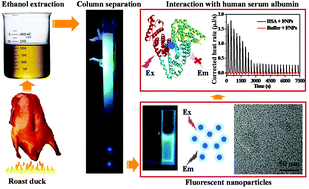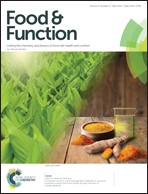Ultrasmall fluorescent nanoparticles derived from roast duck: their physicochemical characteristics and interaction with human serum albumin†
Abstract
Fluorescent nanoparticles (FNPs) produced from roast meat have drawn widespread attention due to their potential hazards to human health. In this paper, the presence of ultrasmall FNPs in roast duck and their interaction with human serum albumin (HSA) were reported. The processing-induced FNPs have an average size of 1.3 nm with a relative fluorescence quantum yield of 4.4%. X-ray photoelectron spectroscopy showed that the FNPs are composed of carbon (70.48%), nitrogen (6.25%), oxygen (22.17%) and sulfur (1.11%), with hydroxyl, carboxyl and amino groups present on their surface. The presence of FNPs could cause fluorescence quenching of HSA, which was ascribed to the static quenching mechanism via the electrostatic interaction as analyzed by isothermal titration calorimetry. The α-helix contents of HSA decreased after the addition of FNPs, demonstrating that these processing-induced FNPs could cause structural alteration of HSA. These results provided insights into the formation of nanoparticles in roast duck, and offered important information about the binding mechanism of these nanoparticles with HSA, which may have physiological implications.

- This article is part of the themed collection: Around the Supermarket: Staple Foods


 Please wait while we load your content...
Please wait while we load your content...